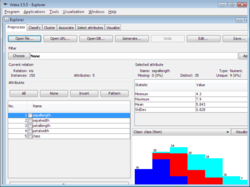Description
Weka contains a collection of visualization tools and algorithms for data analysis and predictive modeling, together with graphical user interfaces for easy access to these functions. [1] The original non-Java version of Weka was a Tcl/Tk front-end to (mostly third-party) modeling algorithms implemented in other programming languages, plus data preprocessing utilities in C, and a makefile-based system for running machine learning experiments. This original version was primarily designed as a tool for analyzing data from agricultural domains, [2] [3] but the more recent fully Java-based version (Weka 3), for which development started in 1997, is now used in many different application areas, in particular for educational purposes and research. Advantages of Weka include:
- Free availability under the GNU General Public License.
- Portability, since it is fully implemented in the Java programming language and thus runs on almost any modern computing platform.
- A comprehensive collection of data preprocessing and modeling techniques.
- Ease of use due to its graphical user interfaces.
Weka supports several standard data mining tasks, more specifically, data preprocessing, clustering, classification, regression, visualization, and feature selection. Input to Weka is expected to be formatted according the Attribute-Relational File Format and with the filename bearing the .arff extension. All of Weka's techniques are predicated on the assumption that the data is available as one flat file or relation, where each data point is described by a fixed number of attributes (normally, numeric or nominal attributes, but some other attribute types are also supported). Weka provides access to SQL databases using Java Database Connectivity and can process the result returned by a database query. Weka provides access to deep learning with Deeplearning4j. [4] It is not capable of multi-relational data mining, but there is separate software for converting a collection of linked database tables into a single table that is suitable for processing using Weka. [5] Another important area that is currently not covered by the algorithms included in the Weka distribution is sequence modeling.
This page is based on this
Wikipedia article Text is available under the
CC BY-SA 4.0 license; additional terms may apply.
Images, videos and audio are available under their respective licenses.

